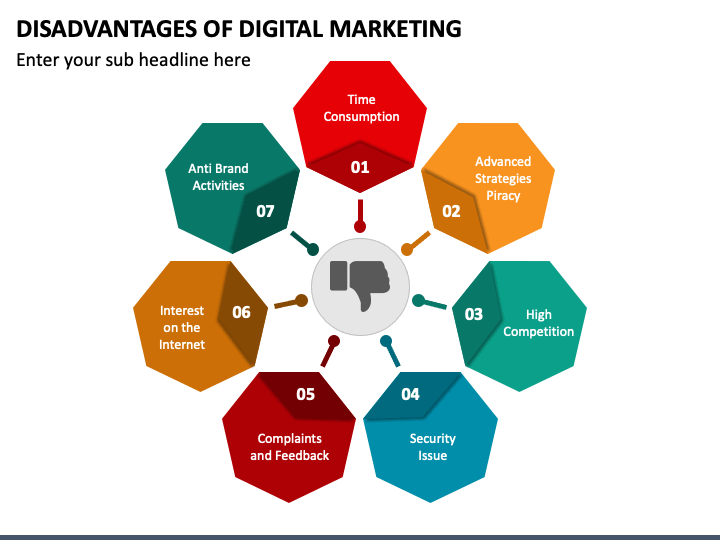Digital marketing can overwhelm customers with excessive ads and infringe on privacy through data collection. It requires internet literacy, which excludes some user demographics.
Digital marketing has revolutionized the way businesses reach their target audience, promising convenience and efficiency. This form of marketing leverages the internet and digital devices, enabling companies to create tailored advertisements for their products or services. While digital marketing strategies are advantageous for many businesses, they also come with notable disadvantages for customers.
As consumers spend increasing amounts of time online, they encounter a saturation of marketing campaigns. This digital bombardment can lead to ad fatigue, where customers become desensitized to promotional messages. Additionally, concerns regarding personal data usage for targeted advertising contribute to privacy issues, leaving customers feeling vulnerable and skeptical about their online interactions. Limited accessibility for those less tech-savvy also creates a barrier, preventing certain groups from benefiting from digital advancements. Recognizing these challenges is crucial for businesses seeking to maintain a positive relationship with their consumer base.
The Paradox Of Choice
The Paradox of Choice plays a pivotal role in the digital shopping experience. In a landscape boasting endless options, customers find themselves at a crossroads. The digital marketing world promises variety and freedom. Yet, it often leads to stress and dissatisfaction. Understanding how this affects customers can reshape our approach to digital marketing.
Overload In Options
Consumers face a digital sea of products and services. Each click reveals more choices. Brands compete for attention with bold claims and flashy graphics. This plethora of options can be overwhelming. Buyers navigate through pages of potential purchases, leading to cognitive overload. This does not always result in a delightful shopping spree.
- Too many choices can sap the joy out of shopping.
- Customers struggle to compare and contrast the ever-growing list of options.
- Analysis paralysis can set in, where the buyer cannot make any decision.
Decision Paralysis
With an overwhelming number of choices, customers may find it hard to choose at all. This phenomenon, known as Decision Paralysis, manifests in the digital market. Consumers delay or abandon their purchases, not out of lack of interest. But due to the fear of making the wrong choice. Simplifying options can help customers make confident decisions.
| Issue | Customer Impact |
|---|---|
| Fear of Wrong Choice | Shoppers hesitate, doubting every option. |
| Delayed Decisions | Purchases are put off, often indefinitely. |
| Lost Sales | Without a clear preference, customers may exit without buying. |
Brands should aim for a balanced offering. They should guide customers to the right choice without causing decision fatigue. A focused approach in digital marketing can create a smoother, more satisfying customer journey.
Privacy Concerns
In an age where information is king, digital marketing practices often involve the collection and analysis of customer data. While this allows for personalized experiences, it raises significant privacy concerns. Let’s delve into the key issues that customers face in the realm of digital marketing.
Data Collection And Usage
Customers are often unaware of the extent to which their data is collected online. From browsing habits to purchase history, digital footprints are constantly tracked.
- Personal information is gathered without explicit consent.
- Cybersecurity risks may lead to data breaches.
- Data is sometimes shared with third parties, raising trust issues.
Targeted Advertising Backlash
Targeted advertising uses customer data to display relevant ads. But not everyone appreciates this strategy. Some perceive it as invasive, leading to a sense of discomfort and frustration.
| Customer Sentiment | Reason |
|---|---|
| Annoyed | Excessive ad frequency |
| Disturbed | Ads based on private information |
| Distrustful | Fear of information misuse |
These privacy concerns are legitimate, demanding more transparent and ethical digital marketing practices. As the digital landscape evolves, both marketers and customers must navigate these waters with care and respect for personal boundaries.
Misinformation And Trust Issues
Misinformation and Trust Issues plague digital marketing, challenging the trust between customers and brands. Consumers face a landscape cluttered with inaccurate information. This environment makes it hard for customers to distinguish between genuine advice and marketing deception.
Spread Of Fake Reviews
One of the glaring flaws of the digital marketplace is the proliferation of fake reviews. Dishonest reviews can significantly misguide consumers. Evaluating products becomes a gamble.
- Exaggerated positive reviews inflate product reputation.
- Negative fake reviews unfairly damage brand credibility.
- Detecting authenticity in reviews demands extra effort from consumers.
Lack Of Authenticity
Authenticity stands as the cornerstone of trustworthy relationships between brands and consumers. However, digital marketing often blurs the lines of what’s real. Brands that overpromise and underdeliver erode consumer trust. This results in a skeptical customer base.
| Authenticity Aspect | Consumer Expectation | Reality of Digital Marketing |
|---|---|---|
| Product Quality | Consistency with descriptions | Often exaggerated |
| Brand Reputation | Based on genuine experiences | Can be artificially boosted |
| Customer Service | Responsive and helpful | May not always live up to promises |

Credit: www.sketchbubble.com
Technology Dependency
Technology Dependency: Digital marketing revolutionizes how customers interact with brands. Yet, it introduces a reliance on technology.
Limited Access For Non-tech Savvy
Not everyone is comfortable with digital gadgets. Some customers find online platforms challenging. This limits their ability to engage with digital marketing campaigns. Brands need to understand that not all consumers are tech-savvy.
- Older generations might prefer traditional methods.
- A steep learning curve can deter potential buyers.
- User-friendly experiences are critical for wider reach.
Outage Vulnerabilities
Power outages or system failures disrupt access to digital services. Customers can feel helpless without the internet or during website downtimes. This can lead to frustration and lower trust levels.
| Issue | Impact on Customers |
|---|---|
| Server Downtime | Lost access to deals and services |
| Internet Outage | Inability to complete transactions |
| Payment Gateway Issues | Payment process interruptions |
Online Shopping Drawbacks
Shopping online changes how we buy things. Sometimes it brings problems. Let’s explore these issues.
Lacking Tangible Experience
Touch and feel are missing in online shopping. You see pictures, not real items. Colors and sizes may look different. It is hard to know the material quality. This can lead to disappointment. See the list below for more issues:
- Photos can be misleading
- No physical checking
- Sometimes size charts are wrong
Return And Refund Hassles
Returns can be a headache. You wait for the mailman again. Sometimes, the process is long and confusing. You might face issues like:
| Problem | Description |
|---|---|
| Complex Policies | Hard to understand rules for returns. |
| Longer Wait Times | Refunds can take weeks. |
| Shipping Costs | Customers might pay for return shipping. |
Check the policy before you buy. Look for shops with free returns. This makes shopping easier.
Digital Ads Invasiveness
Digital marketing transforms how companies reach customers. Yet, it has a downside. Customers often find digital ads too pushy. These ads can pop up when we least expect them. Let’s dive into how this affects our online experience.
Pop-ups And Interruptions
Imagine reading an article or watching a video. Suddenly, a pop-up ad appears. It’s annoying, isn’t it? These are some issues customers face:
- Disrupts browsing: Ads can interrupt your flow, forcing attention elsewhere.
- Distracts from content: You might lose track of the article or video you were engaged with.
- Slows down devices: Pop-ups can make your phone or laptop run slower.
Ad Fatigue
Seeing the same ad over and over can make you tired. This is called ad fatigue. It can lead you to:
- Lose interest: The repeated ad becomes uninteresting and easy to ignore.
- Feel frustrated: The joy of surfing the web turns into frustration quickly.
- Trust brands less: Companies risk making people doubt their sincerity.
Digital Security Risks
Digital marketing connects us with brands online. Yet, it brings digital security risks. Our data can be in danger. Bad people try to break into systems. They can steal credit card information. When we shop online, we face these risks.
Cyber Attacks Exposure
Digital marketing opens doors to cyber attacks. Hackers target online ads to spread malware. They trick users into downloading harmful software. This can harm our computers and mobiles.
- Malvertising: Ads that carry viruses.
- Phishing: Fake sites that look real to steal data.
- Ransomware: Locks your data unless you pay.
Fraudulent Transactions
Shopping online has risks. We enter personal info like addresses and payment details. If a site is not secure, someone can steal these details.
Look for signs of a safe site:
| Sign | Meaning |
|---|---|
HTTPS in the URL |
Secure connection. |
| Padlock icon | Data is encrypted. |
| Trust badges | Site is verified. |
Always use trusted payment methods. This includes credit cards or secure platforms like PayPal.
Customer Service Challenges
Digital marketing has transformed how companies reach their audience. Despite many advantages, not all changes benefit customers. A notable area where users often face issues is customer service. Let’s explore these challenges further.
Automated Service Limitations
Many digital platforms use automated systems for customer service. Though often efficient, these systems come with their own set of problems for users:
- Lack of personal touch: Customers sometimes need human understanding which bots cannot provide.
- Complex queries unresolved: Automated services struggle with unique or complicated issues.
- Navigation difficulties: Users may find themselves stuck in a loop of automated responses.
Long Response Times
Immediate support is a crucial expectation. In the digital world, waiting for a response can be a real inconvenience:
- Delayed communication: Peak periods can overwhelm support teams, leading to long waits for users.
- Impact on user satisfaction: Delayed responses can make customers feel undervalued and ignored.
- Business hours limitation: Some businesses offer live support only during certain hours, not 24/7.
The Illusion Of Deals
The world of digital marketing dazzles with exclusive offers and personalized deals. Yet, sometimes, what glitters isn’t gold. Customers may encounter deceptive savings and unpredictable pricing, all under the guise of ‘special offers’. Let’s uncover the hidden disadvantages that lurk behind these seemingly attractive deals.
False Savings Traps
Discount codes that don’t work and mega sales with inflated prices mislead customers. They think they save money, but they do not. Shoppers get lured into buying more, with the promise of big savings that aren’t real:
- Expired promotions still advertised online.
- Buy one get one deals where the original item price is hiked.
- Minimum spend discounts forcing more purchase than needed.
Dynamic Pricing Issues
Online prices can change fast, based on demand or browsing history. This practice, known as dynamic pricing, may cause customers to pay more than others for the same product:
| Customer | Price Seen | Price Paid | Time of Purchase |
|---|---|---|---|
| First-time visitor | $50 | $50 | Noon |
| Returning customer | $60 | $60 | Evening |
| High-demand period | $75 | $75 | Weekend |
Seeing different prices at different times confuses and frustrates customers. Often, they end up feeling cheated.

Credit: www.researchgate.net
Impersonal Customer Experience
Imagine walking into your favorite store where no one knows your name. The shopkeeper doesn’t remember your last purchase or your preferences. This scenario often happens in digital marketing, labeled as Impersonal Customer Experience. Although digital marketing has a broad reach and convenience, it can fail to replicate the warmth of in-person interactions. Let’s delve into the elements that contribute to this digital shortcoming.
Loss Of Personal Touch
In the digital world, transactions can feel robotic. The lack of human contact can render the experience somewhat sterile and disconnected. Here are key points where digital marketing misses the personal touch:
- Automated responses instead of human conversation
- Standardized content that doesn’t cater to individual preferences
- Difficulty in expressing empathy through screens
When companies rely heavily on technology, the unique needs and nuances of customers might get overlooked. This can lead to a one-size-fits-all approach, which might not suit everyone.
Difficulty In Building Relationships
Building a relationship with customers requires more than just a transaction; it involves trust and emotional connection. In the digital space, challenges include:
- Limited interaction beyond the screen
- Less opportunity for spontaneous conversation
- Harder to create memorable experiences
Bridging the gap between virtual and real-world interactions is hard. Companies need to work extra hard to foster relationships online. Without face-to-face connections, customer loyalty is harder to achieve.
Screen Saturation
Screen Saturation refers to the overwhelming amount of digital content that customers encounter daily. Through various devices and platforms, the influx of advertisements, emails, social media updates, and other forms of digital marketing can be incessant. This constant barrage can have unintended negative effects on consumers.
Health Impacts
Long hours of screen time can lead to several health issues:
- Eyes Strain: Constant gazing at screens can strain the eyes, potentially leading to long-term vision problems.
- Poor Sleep: Overexposure to screens, especially before bedtime, can disrupt sleep patterns.
- Sedentary Behavior: Prolonged periods of inactivity while using digital devices can contribute to a sedentary lifestyle.
Distracted Living
Screen Saturation can pull attention away from important moments:
- Lack of Presence: Focus on devices can detract from real-life experiences and interactions.
- Missed Connections: Relationships may suffer as virtual interactions replace face-to-face time.
- Reduced Productivity: Constant notifications and the urge to check devices can interrupt work and decrease efficiency.
Psychological Tactics
Digital marketing is not just about convenience. It often uses psychological tactics that can deeply affect customer behavior. These methods might not always be in the customer’s best interest.
Understanding the mind games in digital marketing helps customers make better choices. Companies often use psychological triggers to boost sales. But these tactics can sometimes be a disadvantage for customers.
Fear Of Missing Out (fomo)
FOMO is a powerful feeling that marketers tap into. It’s the anxiety that others might be having rewarding experiences from which one is absent. Here’s how it affects decisions:
- Limited-time offers push buyers to act fast.
- Social proof, like user reviews, creates a bandwagon effect.
- Countdown timers increase pressure to buy quickly.
These methods can lead to rushed purchases without careful thought.
Manipulative Marketing
Under this banner, tactics are employed that control customer choices without their clear understanding. Here’s what it includes:
- Ads designed to trigger emotional responses.
- Hidden terms that cause unintended subscriptions.
- Prices set to give the illusion of value.
Such tactics may mislead customers into making decisions that aren’t fully informed.
Environmental Impact
Digital marketing, while innovative, casts a shadow on our environment. Customers may overlook these disadvantages as they enjoy the convenience and accessibility of online platforms. Let’s delve into how digital marketing practices contribute to environmental concerns, such as e-waste and carbon emissions.
E-waste Production
Devices become outdated quickly in the fast-moving digital world. They turn into e-waste. This waste grows as newer technologies emerge.
- Smartphones, tablets, and laptops get replaced often.
- E-waste harms natural habitats when not disposed of properly.
- Recycling rates for e-waste remain alarmingly low.
Carbon Footprint Of Digital Activities
Every online search, streamed video, or digital ad consumes energy. Data centers power these activities. They need lots of electricity. This leads to a larger carbon footprint.
| Activity | Carbon Footprint |
|---|---|
| Emails sent daily | High |
| Hours of streamed content | Higher |
Reducing our digital activities can help. So can choosing greener energy sources.

Credit: www.educba.com
Frequently Asked Questions For What Are The Disadvantages Of Digital Marketing For Customers
How Can Digital Marketing Invade Privacy?
Digital marketing often relies on data collection, leading to privacy concerns. Advertisers track online behavior, sometimes without explicit consent. This accumulation of personal data can result in unwanted targeted advertising and potential data breaches.
Does Digital Marketing Lead To Overspending?
Yes, digital marketing can lead to overspending for customers. The personalized ads and easy online transactions often encourage impulsive buying. Consumers can easily overspend due to the convenience and targeted nature of online advertisements.
Are There Quality Concerns In Digital Marketing?
Indeed, digital marketing can obscure quality. Online, it’s harder to judge a product’s quality without seeing it firsthand. Moreover, the overwhelming number of options may lead to confusion and potential dissatisfaction with choices made under the influence of clever marketing.
What About Misinformation In Digital Marketing?
Misinformation is a significant issue in digital marketing. False advertising and exaggerated claims can mislead customers. This affects their ability to make informed decisions, possibly leading to purchases they regret.
Conclusion
Digital marketing certainly carries unique challenges for consumers. From overwhelming data privacy concerns to the pressure of online ads, customers face a digital landscape that demands constant vigilance. Balancing the conveniences against these disadvantages is key. Smart engagement with digital content is the way forward.
Stay alert, stay informed.






